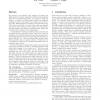Free Online Productivity Tools
i2Speak
i2Symbol
i2OCR
iTex2Img
iWeb2Print
iWeb2Shot
i2Type
iPdf2Split
iPdf2Merge
i2Bopomofo
i2Arabic
i2Style
i2Image
i2PDF
iLatex2Rtf
Sci2ools
SIGGRAPH
1997
ACM
1997
ACM
Metropolis light transport
We present a new Monte Carlo method for solving the light transport problem, inspired by the Metropolis sampling method in computational physics. To render an image, we generate a sequence of light transport paths by randomly mutating a single current path (e.g. adding a new vertex to the path). Each mutation is accepted or rejected with a carefully chosen probability, to ensure that paths are sampled according to the contribution they make to the ideal image. We then estimate this image by sampling many paths, and recording their locations on the image plane. Our algorithm is unbiased, handles general geometric and scattering models, uses little storage, and can be orders of magnitude more efficient than previous unbiased approaches. It performs especially well on problems that are usually considered difficult, e.g. those involving bright indirect light, small geometric holes, or glossy surfaces. Furthermore, it is competitive with previous unbiased algorithms even for relatively sim...
| Added | 07 Aug 2010 |
| Updated | 07 Aug 2010 |
| Type | Conference |
| Year | 1997 |
| Where | SIGGRAPH |
| Authors | Eric Veach, Leonidas J. Guibas |
Comments (0)

